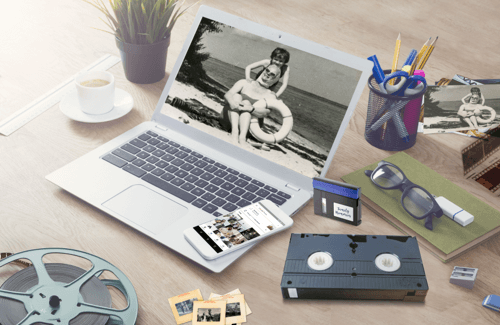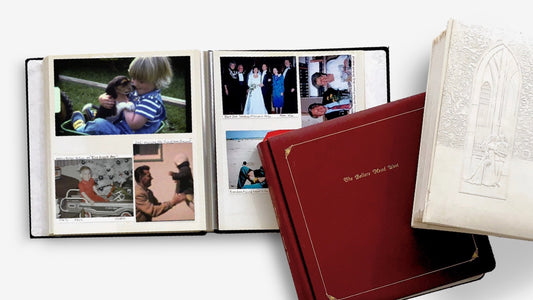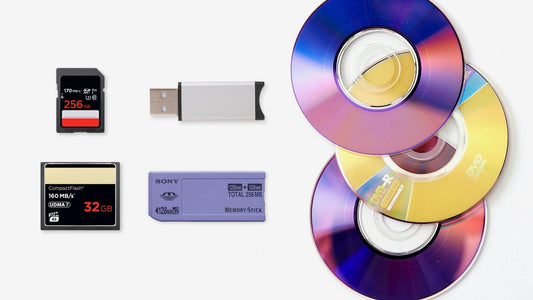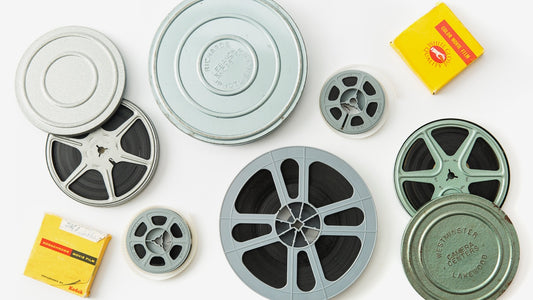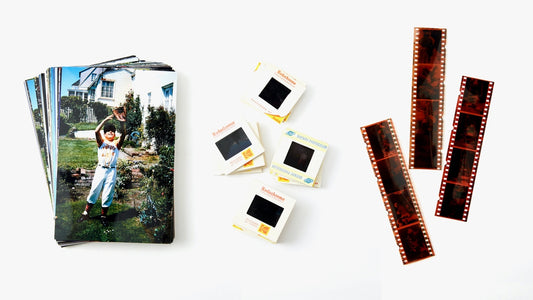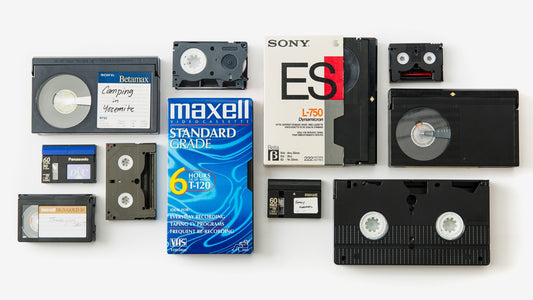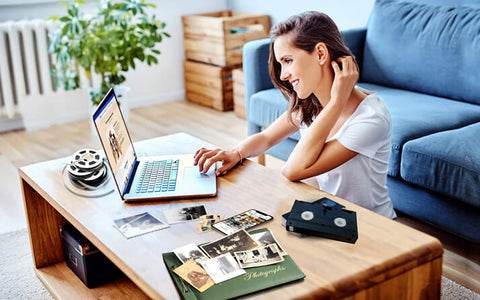Those home movies collecting dust on a shelf are more than just old tapes; they’re a direct link to your family’s past. The laughter, the voices, the wonderfully dated outfits—it’s all there, waiting to be seen again. But time is not on their side. Every year that passes puts those memories at greater risk of fading away forever. Learning how to convert vhs to digital is the single best step you can take to protect them. It’s about bringing those moments out of storage and back into your life, making them easy to watch, share, and enjoy with the people you love.
Key Takeaways
- Act Now to Stop Degradation: VHS tapes lose quality over time, causing colors to fade and sound to warp. Converting them to digital is the only way to stop this decay, protecting your family’s history from being lost forever.
- Choose Your Conversion Path: The DIY route offers control if you have the time and equipment, but a professional service provides expert handling and higher quality, saving you from technical headaches and potential damage to your tapes.
- Protect and Share Your New Digital Files: After converting your videos, create at least two backups (one on a hard drive, one in the cloud) to prevent loss. Then you can focus on organizing and sharing these rediscovered moments with family.
Why You Should Digitize Your VHS Tapes
If you have a box of old VHS tapes tucked away in a closet or attic, you’re holding onto priceless family memories. Those tapes contain first steps, birthday parties, and holiday gatherings you can’t get back. But as time goes on, those memories are at risk. Converting your tapes to a digital format is the best way to protect them for the future, making them easier to watch, share, and enjoy all over again. It’s about taking those moments out of the box and bringing them back into your life.
Save Your Tapes Before They Fade
Let’s be honest, those VHS tapes aren't getting any younger. The magnetic tape inside them degrades over time, causing colors to fade, the picture to get fuzzy, and the sound to warp. Plus, finding a working VCR these days is a challenge in itself. Every year you wait, you risk losing a little more of that precious footage. A professional video transfer service can rescue those memories from deteriorating tapes and obsolete players, preserving them in a format that will last for generations to come. It’s a simple step to ensure your family’s history is saved before it’s too late.
The Perks of Going Digital
Once your home movies are digitized, a whole new world of possibilities opens up. You can finally watch that hilarious family vacation from the 90s on your laptop, smart TV, or phone—no VCR required. Sharing becomes effortless. Imagine sending your parents a clip of their wedding anniversary from 20 years ago or posting a throwback video of your kid’s first birthday on social media. You can also edit clips together to create highlight reels for special occasions. Going digital means your memories are no longer trapped on a shelf; they’re accessible, shareable, and ready to be relived whenever you want.
What Happens to VHS Tapes as They Age?
VHS tapes are made of a thin layer of magnetic particles on a plastic base, and this format is surprisingly fragile. Over decades, the magnetic signal that holds your video and audio information weakens, leading to a gradual loss of quality. This can show up as static, color loss, or distorted sound. The physical tape itself can also become brittle, wrinkled, or even grow mold, especially if it wasn't stored in a cool, dry place. Unlike a digital file that can be copied perfectly forever, each play on a VCR causes a tiny bit of wear and tear. Digitizing is the only way to freeze that moment in time and stop the decay.
Your DIY VHS Conversion Toolkit
Ready to roll up your sleeves and tackle this project yourself? I love a good DIY, and converting your own VHS tapes can be a really rewarding experience. Before you start, you’ll need to gather a few key pieces of equipment to create a bridge between your analog tapes and your modern computer. Think of it as building your own personal memory-digitizing station. It’s a fun way to reconnect with your family’s history while learning a new skill.
Here’s a quick rundown of what you’ll need to get started:
- A working VCR: This is the star of the show. You’ll need one that can play your tapes smoothly.
- A computer: A desktop or laptop will work just fine.
- An analog-to-digital video capture device: This little gadget is the magic wand that turns the analog signal from your VCR into a digital file your computer can understand.
- RCA cables: You’ll likely need the classic red, white, and yellow cables to connect your VCR to the capture device.
- Conversion software: This is the program on your computer that will record the video feed.
It might sound like a lot, but once you have everything in front of you, it’s a pretty straightforward setup. The most important part is making sure each component works well before you begin the actual conversion process. A little bit of prep work now will save you from potential frustration later and ensure your home movies look their best.
Finding the Right VCR
First things first, you need a reliable VCR. If you don’t have one tucked away in a closet, don’t worry. You can often find them for a good price at local thrift stores or online on sites like Facebook Marketplace or eBay. The key is to find one that’s in good working condition. A faulty VCR can damage your precious tapes or produce a poor-quality transfer, and nobody wants that. Before you connect it to your computer, I recommend testing it with a tape you don’t mind losing, just in case. Pop it in, press play, and make sure the picture is clear and the sound is steady. A little bit of prep here can save you a lot of headaches.
Connecting Your VCR to Your Computer
Once you have your VCR, it’s time to get it talking to your computer. This is where the video capture device comes in. It acts as a translator between your old-school VCR and your modern machine. Start by plugging the red, white, and yellow RCA cables into the corresponding “OUT” ports on the back of your VCR. Then, connect the other end to the “IN” ports on your capture device. Next, plug the USB end of the capture device into an available USB port on your computer. That’s it! This simple chain of connections allows the video and audio from your VHS tape to travel into your computer, ready to be recorded as a digital file.
Choosing Your Conversion Software
With your hardware all hooked up, you’ll need software to capture the video. Many video capture devices come with their own basic software, which is often the easiest way to get started. You’ll just need to install it from the included disc or the manufacturer’s website. If your device didn’t come with software or you want more control, a free program like OBS Studio is a fantastic option. After installing the software, you’ll need to select your capture device as the video and audio source. This tells the program where to look for the incoming signal from your VCR. Taking a moment to confirm these settings will ensure you get a clean recording.
Where to Save Your Digital Videos
After you’ve captured your home movies, you need a safe place to store them. You can save the digital files directly to your computer’s hard drive, but I highly recommend creating backups. You can copy the files to an external hard drive, a USB flash drive, or upload them to a cloud service like Google Photos or Dropbox. Cloud storage is great because it makes your videos easy to access and share with family and friends. If managing files and backups sounds like a chore, you might prefer a professional service. A professional video transfer can handle the entire process for you and deliver your digitized memories in a secure, shareable online account.
How to Convert VHS to Digital: A Step-by-Step Guide
Ready to roll up your sleeves and tackle this project yourself? Going the DIY route can be a rewarding experience. It gives you full control over the process, from start to finish. There are a couple of common ways to do this, and we’ll walk through each one. Just remember to be patient—this isn't a quick process, but seeing those old home movies come back to life is worth the effort. Let's get started on the right path to digitizing your memories.
Method 1: Use a VHS-to-DVD Combo Player
If you can find one, a VHS-to-DVD combo player is a straightforward option. These machines are designed to do exactly what you need: play a VHS tape and record its contents directly onto a blank DVD. The process is as simple as pressing play on the VHS side and record on the DVD side.
Once you have your movie on a DVD, the next step is to get it onto your computer. You’ll need to use a program to “rip” the video file from the disc. A popular and free software for this is HandBrake, which can convert the DVD video into a common digital format like an MP4 file that you can easily save and share.
Method 2: Use a Video Capture Device
This is the most common DIY method for converting VHS to digital. It involves a small piece of hardware called a video capture device. Think of it as a bridge between your old VCR and your modern computer. You’ll connect your VCR to the capture device using RCA cables (the red, white, and yellow ones), and then plug the device into your computer’s USB port.
These devices come with software that allows you to record the video as it plays from the VCR. Popular brands include Elgato and EasyCap, but many affordable options are available online. This method gives you more control over the final file format and quality settings directly on your computer.
Connecting Directly to Your Computer
Once your VCR and capture device are hooked up to your computer, it’s time to manage the software. Open the program that came with your device and look for the settings menu. First, you’ll need to select your capture device as the video and audio source so the software knows where to pull the feed from.
Next, check the video settings. For VHS tapes, the aspect ratio should typically be 4:3. You may also see an option for "deinterlacing," which helps smooth out the picture and is usually a good idea to enable. Take a moment to run a short test recording to make sure everything looks and sounds right before you digitize an entire tape.
Getting the Best Picture and Sound
The quality of your digital video depends heavily on the condition of your original tapes. Before you begin, make sure your tapes have been stored properly—in a cool, dry place away from direct sunlight. Heat and humidity are the biggest enemies of magnetic tape. It’s also a great idea to clean the heads on your VCR before you start, as a dirty player can cause a fuzzy or distorted picture. If your tapes are showing signs of damage, a professional video transfer service might be a safer bet to get the best results.
What to Expect: Time and Cost
Be prepared for this project to take some time. Digitizing happens in real-time, which means a two-hour tape will take two hours to record onto your computer. If you have a large collection, this can add up quickly.
In terms of cost, you’ll need to factor in the price of a working VCR (if you don’t have one) and a video capture device, which can range from $20 to over $100. When you compare this to professional services, which can cost anywhere from $7.50 to $35 per tape, the DIY route can be cost-effective for larger collections if you have the time to invest.
Don't Want to DIY? Let the Pros Handle It
If you’ve read through the DIY steps and are feeling a little overwhelmed, you’re not alone. Converting old tapes is a time-consuming project that requires specific equipment and a bit of technical know-how. For many of us, the risk of accidentally damaging a one-of-a-kind family video just isn’t worth it. Plus, who has a spare VCR lying around these days?
Choosing a professional service is a fantastic alternative that saves you time, stress, and the hassle of hunting down old gear. Instead of spending your weekend troubleshooting connections and monitoring conversions, you can hand your precious memories over to experts who do this every single day. They have the right equipment, the experience to handle fragile tapes, and a process designed to get the best possible quality from your old media. It’s a simple way to ensure your memories are preserved safely and correctly, without adding another major project to your to-do list.
How YesVideo Can Help
This is where we come in. At YesVideo, we specialize in carefully converting your cherished memories into digital formats you can easily enjoy and share. We handle everything from VHS tapes and camcorder tapes to old film reels and photo albums. Our whole process is designed to be simple for you. You just send us your media in our secure, pre-paid box, and our team of technicians in the USA gets to work, handling each tape and photo by hand. We use professional-grade equipment to ensure a high-quality transfer, giving your memories the care they deserve.
What to Look for in a Conversion Service
When you’re trusting a company with irreplaceable memories, you want to know you’ve made the right choice. Look for a service with a long history of experience, especially with older, more fragile formats. A reputable company will be transparent about their process, from how they receive your tapes to how they handle them in their facility. Check for customer reviews and testimonials to see what others have experienced. You should also confirm what digital delivery options are available—whether it’s a digital download, a USB drive, or DVDs—so you can choose what works best for your family.
Comparing the Costs: DIY vs. Professional
While the DIY route might seem cheaper at first, the costs can add up quickly. You’ll need to buy a working VCR, a video capture device, and software, not to mention the value of your own time spent on the project. If a tape breaks in a cheap player, the memory could be lost forever. A professional video transfer service has a clear pricing structure, so you know exactly what you’re paying for. Think of it as an investment in quality, security, and convenience—you’re paying for expertise and peace of mind, ensuring your videos are preserved without the risk or hidden costs of doing it yourself.
What Kind of Quality Can You Expect?
It’s important to have realistic expectations. The quality of your final digital video will largely depend on the condition of the original VHS tape. Tapes degrade over time, so a 30-year-old video won’t magically transform into an HD film. However, a professional service can capture the best possible version of what’s on that tape. We use high-end, maintained equipment that provides a more stable, clearer transfer than most consumer-grade VCRs. Our technicians monitor the process to make adjustments, ensuring the best picture and sound your tape can produce, giving your memories a new digital life.
Tips for Getting the Best Quality Conversion
Getting a great digital copy of your home movies isn't just about hitting the record button. The quality of your final video depends heavily on the condition of your original tapes and the equipment you use. Think of it like making a photocopy—if the original page is crumpled and faded, the copy will be, too. While you can't turn a grainy 1980s home video into a 4K masterpiece, you can take steps to get the cleanest, most stable, and most watchable version possible. This is your chance to preserve the memory as it was, not a degraded version of it.
A little prep work goes a long way, whether you’re tackling this project yourself or sending your collection to a professional service. These tips will help you prevent common issues like a fuzzy picture, muffled audio, or a video that’s worse than the original tape. By paying attention to these details, you ensure that the digital files you create or receive are the best possible representation of your precious memories. If you'd rather leave the technical details to experts, a video transfer service uses professional-grade, maintained equipment to get the best results from every single tape, saving you the hassle of troubleshooting old gear.
Check Your Tapes Before You Start
Before you plug anything in, take a moment to inspect your tapes. Look for any obvious signs of damage, like a cracked casing, visible mold, or a tangled ribbon. If a tape looks dusty, you can gently wipe the cassette with a soft, dry cloth. Taking a few simple steps to prepare your VHS tapes can make a big difference in the quality of your digital conversions. A great trick is to fast-forward the tape all the way to the end and then rewind it back to the beginning. This helps tighten any slack in the tape, which can prevent it from getting snagged in the VCR.
Choose the Right Video Settings
If you're going the DIY route, the settings you choose in your video capture software are crucial. You don't need to be a video engineer, but a few tweaks can make a noticeable difference. Look for the output format settings; a format like MPEG-2 is often a good choice for analog sources because it balances quality and file size well. If your software has a "quality" or "bitrate" slider, push it as high as your computer can handle without causing the video to skip or stutter during recording. A higher bitrate generally means a better-quality video, so it's worth experimenting with a short test clip first.
Make Sure the Audio is Clear
The sound of your family’s voices and laughter is just as important as the picture. Poor audio quality during a conversion is often caused by old, faulty cables or a dirty connection. Before you start converting a full tape, record a one-minute test clip and listen to it carefully with headphones. Do you hear a persistent hum, static, or crackling? If so, try wiggling the audio cables to see if the connection is loose, or try a different set of cables altogether. Ensuring the audio is captured correctly is a simple step that can significantly enhance the final video and preserve the full memory.
Keep Your Equipment Clean
A dusty VCR is one of the biggest culprits behind poor-quality conversions. Over time, dust and debris can build up on the VCR’s heads—the part that actually reads the tape. This can lead to a snowy picture, tracking lines, or muffled audio. In a worst-case scenario, a dirty VCR can even damage your irreplaceable tapes. Before you begin your project, run a VCR head-cleaning cassette through the player a couple of times. If the VCR has been in storage for years, it might be worth getting it professionally serviced to ensure it’s in top working condition.
Store Your Tapes Properly
How you store your tapes directly impacts their longevity and the quality you can expect during conversion. The ideal environment is a cool, dry place away from direct sunlight and extreme temperature changes. Heat and humidity are the enemies of magnetic tape, as they can cause it to warp, stretch, or grow mold. It’s also smart to store them upright, like books on a shelf, to prevent the tape edges from getting damaged. Finally, keep them away from anything that generates a strong magnetic field, like speakers or power transformers, as magnets can erase the recording.
Now That They're Digital, What's Next?
Congratulations! You’ve successfully brought your precious home movies into the digital age. The hardest part is over, but the journey isn’t quite finished. Now that your memories are safe from the wear and tear of time, you can focus on organizing, protecting, and—most importantly—enjoying them. Taking a few extra steps right now will ensure your newly digitized videos are easy to find, share, and cherish for decades to come. Think of it as creating a beautiful, modern home for your family’s history.
Pick the Right File Format
When you convert your VHS tapes, the file format you choose can make a big difference in how you store and share your videos. While it’s good to have realistic expectations about the final quality (a digital file can’t magically fix a blurry tape), picking a versatile format is key. For most people, MP4 is the perfect choice. It offers a great balance of high quality and manageable file size, and it’s compatible with almost every device, from your phone and computer to your smart TV. This means you can easily watch, edit, and share your memories without any technical headaches.
Create Backups (You'll Thank Yourself Later)
You went to all this trouble to save your videos from fading away on old tapes; don't risk losing them to a computer crash. Digital files need protection, too. The best strategy is to have multiple copies in different places. A good rule of thumb is to keep one copy on your computer or an external hard drive, and another in a secure cloud storage service like Google Drive or Dropbox. Using the cloud is fantastic because it gives your family easy access to the videos. They can watch them anytime or download their own copies, ensuring these moments are safe from any single point of failure.
Share Your Memories with Family and Friends
This is where the real fun begins! The whole point of this project was to bring these memories back to life, and now you can share them with the people who matter most. You can send direct links to specific videos, create a shared family folder in the cloud, or even put together a highlight reel for a special occasion like a birthday or anniversary. Imagine the joy of surprising your parents with a video of their wedding or showing your kids what you looked like as a toddler. Sharing these moments is a powerful way to reconnect with your past and create new memories together.
Keep Your Digital Files Safe for Years to Come
Long-term preservation is all about good organization. To make sure your digital files are safe and easy to find for years to come, start by creating a simple folder system. You could organize them by year, by event (like "Christmas 1995" or "Summer Vacation 2001"), or by the original tape label. Rename the files to something descriptive so you know what’s in them at a glance. If you have photos or other digital media, you can even consolidate everything with a digital media transfer to keep your entire family archive in one tidy place. Periodically check on your files and be prepared to move them to new storage as technology changes.
Troubleshooting Common Conversion Problems
Even with the best intentions, a DIY digitization project can hit a few snags. Old tapes, aging equipment, and tricky software can all present challenges. Don’t get discouraged if you run into issues—it’s a normal part of the process. The key is knowing how to identify the problem and what steps to take next. Whether you're dealing with a VCR that won't cooperate or a video that just doesn't look right, a little troubleshooting can go a long way. Here’s a look at some common conversion hurdles and how you can work through them.
What to Do When Tech Fights Back
It can be incredibly frustrating when your VCR eats a tape or your computer refuses to recognize the capture device. Technical glitches are one of the biggest risks of DIY conversion, and in some cases, they can lead to poor-quality video or even permanently damage your tapes. If you’re feeling overwhelmed by error messages or equipment failures, take a step back. Sometimes the best solution is to recognize when a project is beyond your current setup. To avoid the pitfalls of DIY methods, consider letting a professional service take over. It can save you time and protect your irreplaceable memories from being lost for good.
Fixing Blurry Video or Muffled Sound
If your digital video looks fuzzy or the audio is muffled, remember that you’re working with analog media that has degraded over time. While you can’t magically transform a 30-year-old home movie into 4K quality, you can make small improvements. Some software offers filters to reduce visual noise or sharpen the image slightly. However, these tools can only do so much. For the best possible outcome, a professional video transfer service uses commercial-grade equipment and techniques to enhance the picture and sound, correcting color and stabilizing the image to restore your memories as clearly as possible.
How to Troubleshoot Your Gear
When a transfer fails, your first step should be to check your equipment. Start with the VCR—use a head-cleaning tape to ensure there’s no dust or debris interfering with playback. Next, inspect the VHS tape itself for any visible damage like creases, mold, or a brittle, snapped tape. Some formats, like VHS-C, are more fragile and prone to errors. If the tape looks fine, check your cables to make sure they are all securely connected to the VCR, capture device, and computer. A loose connection is often the simple culprit behind a failed video capture.
Tips for Managing a Big Project
Digitizing a large collection of tapes is a marathon, not a sprint. It’s important to have realistic expectations about the final quality from the start; some tapes may have aged better than others. To make the project feel more manageable, break it down into smaller batches. Organize your tapes by year or event and tackle a few at a time. Before you begin, it also helps to read up on common digitization mistakes, like using the wrong file format. A little planning can save you from major headaches down the road and ensure your project is a success.
DIY vs. Professional Service: Which is Right for You?
Deciding whether to digitize your VHS tapes yourself or hand them over to a professional can feel like a big choice. Both paths have their merits, and the right one for you really comes down to four key things: your time, your budget, your quality standards, and your comfort level with technology. Let's break it down so you can make a decision that feels right for your precious memories.
How Much Time Do You Have?
Digitizing tapes isn't a quick background task; it happens in real-time. A two-hour tape takes at least two hours to capture, and that’s before any setup or editing. If you have a box full of tapes, you’re looking at a multi-day project. You have to play each tape from start to finish to convert it, which means you'll be monitoring the process for hours on end. Think about whether you want to spend your weekends tethered to a computer or if you’d rather hand off the project. For a fast and simple solution, a professional video transfer service handles everything for you, saving you hours of work.
What's Your Budget?
Doing it yourself might seem cheaper at first, but the costs can add up. You’ll need a working VCR, a video capture device, and software, which can easily cost over $100. Professional services typically charge per tape, with prices often dropping with bulk orders. It’s worth calculating the total cost for your collection both ways. Investing in a professional service means you pay once for guaranteed, high-quality results without buying gear you might only use once. This way, you can be sure your investment goes directly toward preserving your memories, not just acquiring equipment.
How Important is Picture-Perfect Quality?
Your home movies are irreplaceable, so quality is key. DIY conversions can result in poor resolution, color issues, or even damaged tapes if your VCR isn't in top shape. Professional services use broadcast-quality equipment and have technicians who can clean tapes and make adjustments for the best possible picture and sound. They are equipped to handle fragile, aging media with care. If you want your memories to look as good as they possibly can, trusting an expert with your film transfer is the safest bet to ensure your videos are preserved beautifully for years to come.
Do You Have the Right Skills and Gear?
A successful DIY project requires more than just plugging in a few cables. You’ll need to be comfortable installing drivers, configuring software settings, and troubleshooting issues like dropped frames or audio sync problems. If that sounds more frustrating than fun, you’re not alone. The technical challenges can quickly turn a nostalgic project into a major headache. A professional service like YesVideo eliminates these hurdles. You just send in your tapes, and they handle all the complex work, delivering digital files that are ready to watch and share with your family.
Your Checklist for a Smooth Project
Whether you're tackling this project yourself or handing it off to the pros, a little prep work goes a long way. This checklist will walk you through the key steps to make sure your VHS conversion project is a success from start to finish. Think of it as your game plan for turning those dusty tapes into digital treasures you can actually watch and share. Getting organized now saves you from headaches later and helps ensure the final quality is the best it can be. We’ll cover everything from sorting your collection to giving the final files a once-over. Let’s get your memories ready for their digital debut.
Plan and Organize Your Tapes
First things first, let's get your collection in order. Gather all your tapes and take a look at what you have. It helps to label everything clearly with dates, events, or the people in them. This not only helps you decide which tapes to convert first but also makes naming the digital files so much easier later on. Before you begin a video transfer, taking a few simple steps to prepare your VHS tapes can make a big difference in the quality of your digital conversions. Gently wipe any dust off the cassettes with a soft cloth. This simple organization will streamline the entire process and get you one step closer to reliving those moments.
Test Your Setup First
If you're going the DIY route, don't just dive into your most precious tape. Do a test run first. Connect all your gear—the VCR, the capture device, and your computer—and try converting a few minutes of a less important tape. This is your chance to work out any kinks in the system. Check that the picture is clear and the sound is coming through properly. A great tip is to run the entire tape in fast-forward before you start the actual conversion. This helps you spot any physical damage or snags in the tape that could cause trouble during playback. A quick test saves a lot of potential frustration.
Keep an Eye on the Conversion
Once you press record, your job isn’t quite done. Converting VHS tapes isn't a "set it and forget it" kind of task. It’s best to stick around and monitor the process, at least for the first few minutes of each tape. DIY digitization can sometimes lead to poor quality or even tape damage if you're not careful. Watch the playback on your computer screen to make sure there are no tracking issues (those fuzzy lines) or audio dropouts. Catching a problem early means you can stop, adjust your VCR's tracking, and start again without losing the whole tape. It requires a bit of patience, but it's worth it for your memories.
Do a Final Quality Check
After the conversion is complete, take a moment to review your new digital files. It’s helpful to have realistic expectations about the final video quality—a 30-year-old home movie won't magically become a 4K blockbuster. The goal is to preserve the original as faithfully as possible. Watch the video from beginning to end to make sure the entire tape was captured. Check that the audio is synced with the video and that there are no major glitches. Once you've confirmed everything looks good, you can breathe a sigh of relief. You’ve successfully saved another memory from fading away, just like you can with a photo transfer for your old pictures.
Related Articles
- Convert VHS to Digital: The Ultimate 2024 Guide – YesVideo
- Best VHS Video to Digital Converters: Top Picks – YesVideo
- VHS Tape to Digital: The Ultimate 2024 Guide – YesVideo
- Change VHS to Digital: The Ultimate 2024 Guide – YesVideo
Frequently Asked Questions
Will my digitized videos look as clear as modern HD videos? It's best to think of digitization as preserving the quality of your original tape, not upgrading it. The final video will be a faithful digital copy of what’s on the VHS tape, so a 30-year-old home movie won't suddenly look like it was shot on a new smartphone. A professional service can often get a cleaner, more stable picture than a DIY setup because they use high-end equipment, but the goal is always to capture the memory as it is.
I have a huge box of tapes. Is it really cheaper to do it myself? While the per-tape cost of a professional service might seem higher at first, the DIY route has its own expenses. You'll need to buy a reliable VCR, a capture device, and potentially software, which can add up. You also have to consider the value of your time, since digitizing happens in real-time. For a large collection, the cost of equipment and the hours you'll spend on the project can make a professional service a more practical and sometimes even more affordable choice.
What if some of my tapes look damaged or have mold on them? If you see any physical damage like a cracked case, a tangled ribbon, or especially mold, it's best not to play the tape in your own VCR. A damaged tape can break further and permanently ruin the VCR you're using. This is a situation where handing it over to professionals is the safest option, as they have the tools and experience to safely handle and sometimes even repair fragile media.
Besides VHS, I have other types of tapes and even film reels. Can those be converted too? Yes, absolutely. Many families have a mix of different media formats from over the years. Most professional digitization services can handle a wide variety of formats beyond just standard VHS tapes. This includes camcorder tapes like Hi8 and MiniDV, old 8mm or 16mm film reels, and even photo prints and albums. It's a great way to consolidate your entire family archive all at once.
After my videos are digitized, what's the single most important step to protect them? The most critical step is to create backups. A digital file is only as safe as the device it's stored on, and hard drives can fail. The best practice is to keep at least two copies of your files in different places. For example, save one copy on an external hard drive that you keep at home and upload another copy to a secure cloud storage service. This ensures your memories are safe from any single accident.





